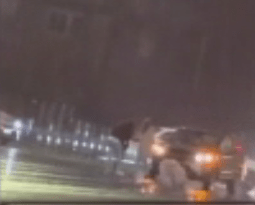The province of British Columbia, including the Okanagan region, has experienced a concerning surge in pedestrian-involved collisions, prompting urgent calls for increased caution from both pedestrians and drivers. The Royal Canadian Mounted Police (RCMP) have reported a notable uptick in these incidents, highlighting several recent cases that underscore the severity of the issue. These include a fatal collision on Highway 97 in Kelowna, another incident on Harvey Avenue, an injury involving a young woman near the Delta Grand Hotel resulting in a traumatic brain injury, and the injury of the Okanagan Sun Football team’s head coach in a crosswalk. These incidents paint a stark picture of the vulnerability of pedestrians and the potential for devastating consequences.
Several factors contribute to this alarming trend. Weather conditions play a significant role, with decreased visibility during darker hours exacerbated by fog, rain, and snow, all common occurrences during the fall and winter months. The Insurance Corporation of British Columbia (ICBC) confirms this seasonal pattern, reporting that 42% of pedestrian-involved accidents occur between October and January, with December being the most dangerous month. This statistical evidence underscores the heightened risk during this period and emphasizes the need for extra vigilance. The combination of diminished visibility and adverse weather creates a hazardous environment for pedestrians, increasing the likelihood of collisions.
ICBC, acutely aware of the dangers, has launched a public awareness campaign to mitigate these risks. Their primary message centers on the importance of pedestrian visibility. They recommend wearing reflective clothing or accessories, utilizing flashlights, or even employing the backlight of mobile phones to enhance visibility to drivers, especially during low-light conditions. These simple yet effective measures can significantly reduce the chances of being overlooked by motorists. Furthermore, ICBC stresses the importance of cautious behavior at intersections, where a staggering 80% of pedestrian accidents occur.
The corporation’s safety recommendations extend beyond visibility and include crucial advice for navigating intersections safely. They advocate for the consistent use of designated crosswalks, discouraging jaywalking, which often places pedestrians in unpredictable and dangerous situations. Making eye contact with drivers before crossing is another vital step, ensuring mutual awareness and reducing the risk of miscommunication. Furthermore, removing headphones allows pedestrians to be fully attentive to their surroundings, including approaching vehicles and potential hazards. These practices contribute to a safer pedestrian experience, minimizing the chances of accidents.
Beyond ICBC’s recommendations, law enforcement officials add another critical piece of advice: avoid distractions, particularly texting while walking. The RCMP emphasizes that divided attention can significantly impair a pedestrian’s ability to react to their surroundings, increasing vulnerability to accidents. Just as distracted driving poses a severe threat, distracted walking creates a similar hazard for pedestrians. By remaining attentive and aware of their environment, pedestrians can minimize their risk. This reinforces the crucial message that responsible pedestrian behavior is just as essential as responsible driving in preventing collisions.
The collective responsibility for pedestrian safety extends to drivers as well. The RCMP and ICBC urge drivers to exercise heightened caution during these high-risk months. Reducing speed, especially in areas with high pedestrian traffic, is crucial. Scanning the road diligently for pedestrians, even in low-light conditions, allows drivers to react promptly and avoid potential collisions. Being mindful of the increased presence of pedestrians during these times can significantly reduce the risk of accidents. Ultimately, a shared commitment to safety from both pedestrians and drivers is essential for creating safer roads for everyone. This collaborative effort can significantly reduce the number of pedestrian-involved accidents and contribute to a safer traffic environment for all.

